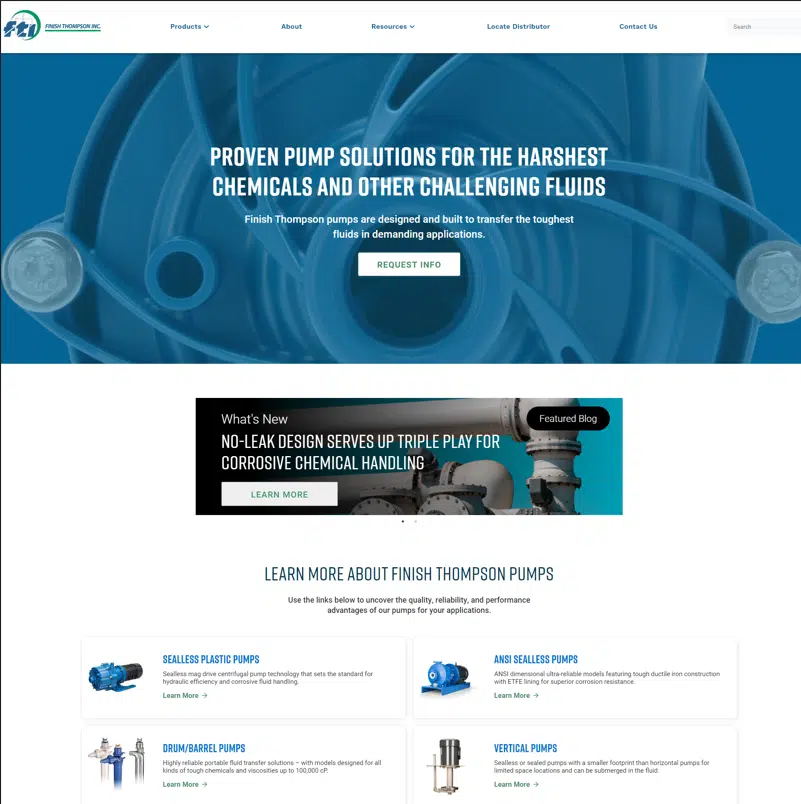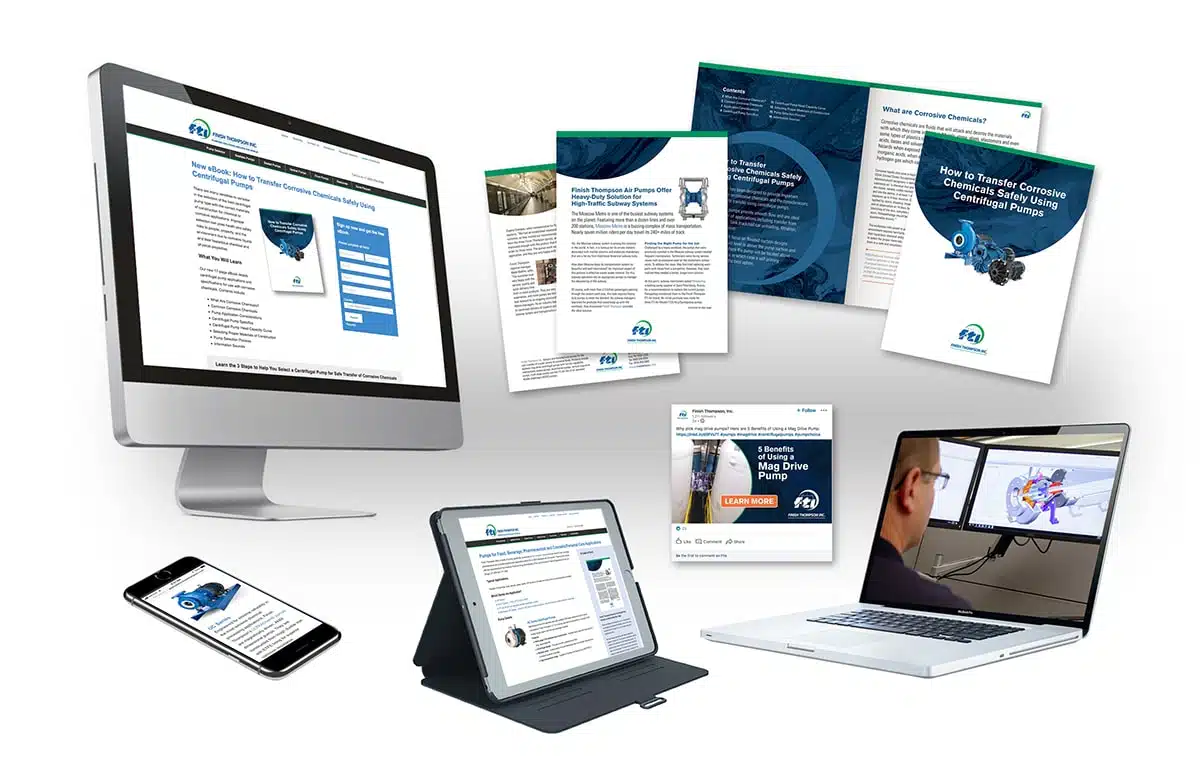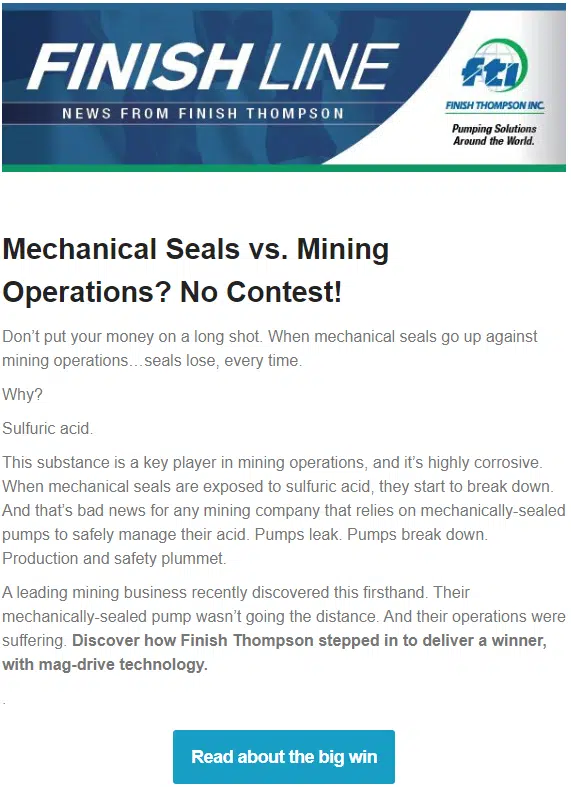How to map your selling process to the way your B2B customers buy: A case study
Learn how an industrial manufacturing company transformed their marketing strategy to meet evolving B2B buying behavior.
B2B buying has changed dramatically in the last decade, and marketers need to change with it. Let’s look at a company that figured out how to change their marketing to meet their buyers’ behavior and create a positioning that added greater value to their perception in the marketplace.
How an industrial chemical pumps manufacturer modernized its go-to-market strategy
Finish Thompson is a family-owned manufacturer of pumps for moving fluids — usually chemicals — founded in 1951 and based in Eerie, Pennsylvania. Their company is distinguished by a culture of trust and service, where business is often done on a handshake.
This is a fairly dirty industrial category, where the liquids are often unclean and the applications can be dangerous. Most of their customers operate in highly regulated industries, too. Customers especially value a supplier who is reliable and trustworthy.
These industrial pumps are used in various industries that involve fluid handling, like chemicals, water management, aquariums, mining, pulp and paper, pharmaceuticals, steel, circuit boards, electronics and food and beverage. Finish Thompson has plenty of room for future growth. And they are continuing to expand their production capabilities.
In going to market, the company has traditionally relied on distributors, including catalogs, to access the market opportunity. They enjoy relationships with about 300 distributors, covering many countries on six continents.
Industrial buying behavior has changed dramatically with the rise of countless online platforms in recent decades. Buyers do most of their initial research online instead of directly talking to a supplier. They use search engines and visit industry publications and associations online well before any conversation with a live salesperson.
This means that sellers must be easy to find online and provide answers to the questions buyers are likely to ask. Finish Thompson realized it needed to refresh its go-to-market strategy and especially to update its online presence.
Further, Finish Thompson was still positioned as a product company, even though their capabilities were much broader. Buyers needed to know that Finish Thompson could help them at all stages of making an industrial pump purchase decision, from product design and manufacturing to installation, service and maintenance.
The company realized they needed to reposition themselves as a solution provider rather than a manufacturer. So, in 2018, they brought in the Cleveland-based B2B marketing agency RH Blake, which for more than 30 years has specialized in the manufacturing sector.
RH Blake took the company through its strategic process, a roadmap for gaining customer insight based on voice of the customer (VoC) methods. They conducted extensive interviews with all parties in the demand chain, from employees to distributors to end customers.
What they learned was enlightening. It became clear that Finish Thompson needed to deliver information online and off to reposition themselves from a product to a solutions company and help their customers move along their buying journey in Finish Thompson’s direction.
Thanks to these insights, Finish Thompson was able to develop an improved strategy for its marketing communications. This entailed a program in five parts. Let’s review them now.
Shifting from a product company to a solution provider: A 5-step program
1. Messaging around the solutions theme
The first part of the new strategy was preparing fresh content and a new website to deliver the message about Finish Thompsons’s solutions capabilities and its expertise in various industries and pumping technology applications.

They also produced a stream of helpful content, like white papers and case studies, intended to demonstrate Finish Thompson’s expertise and help customers and prospects learn how to solve their fluid movement problems. All this was designed to establish Finish Thompson as a helpful, reliable and trustworthy partner.

2. SEO to meet buyer research
The VoC research clearly showed how prospects research solutions online, or perhaps they ask a trusted partner for solution ideas and then follow up via online validation. So, the team conducted thorough research around the most important keywords potential customers were using to research the solutions they needed. They used tools like Semrush and Google Ads and researched among distributors, customers and competitors.
Especially interesting was their early recognition that lead quality is far more important than quantity in a niche field like industrial pumps. The SEO team emphasized phrases and word strings, which were more likely to indicate a serious need. While fewer in number, these longer keyword phrases were less competitive and more likely to represent a qualified prospect.

The SEO portion of the program shows strong and steady improvements in Finish Thompson search visibility from 2020 through 2023.
3. Content marketing for lead generation
With an array of valuable content, the team generated leads based on downloads of industry-specific and application-specific case studies and white papers for a steady stream of productive sales leads.
Here’s an example of an informative case study about a water treatment facility in Tennessee that benefited from Finish Thompson’s magnetic sealless pumps to withstand the harsh bleaches in their system, reduce leaks and reduce maintenance costs. The accompanying webform provides the information the sales team needs for follow-up.

4. Continued advertising in trade publications
The company promoted itself in trade publications like Processing and Water Technology. But the messaging was focused less on products and more on Finish Thompson solutions and applications expertise.
5. Distributor communications
Thanks to the VoC research, where their distributors said things like, “Being more familiar with Finnish Thompson would help us win more business,” the team created an ongoing set of communications to keep distributors informed and keep the company in mind with them.
Communications included a monthly newsletter with product and solution updates, testimonials, case studies and training materials. They also created a distributor event and sales collateral for distributors to use in the field.

So, what were the results of all this activity? Casey Bowes, CEO of Finish Thompson, provided this complimentary testimonial:
“RH Blake has helped us penetrate our target markets by implementing a more end-customer-focused marketing approach. Leveraging the insights gained during the initial strategy work, RH Blake has created marketing programs that have generated awareness, preference and leads among a highly technical, risk-averse audience.”
Key takeaways
So what can we learn from this case study?
Research into customer needs is essential to marketing success. This case also illustrates the importance of bringing all parties into the research, not just end customers. Finish Thompson involved their distributors and employees to gain valuable, actionable insights.
You must have a deep understanding of how your customers buy. In B2B environments, buying processes tend to be very well-defined and complex, involving multiple parties (sometimes as many as 10 or 20 people!). Once you understand the customer’s buying process, you can vastly reduce waste and increase results by mapping your selling process to it. B2B marketing today is about finding ways to help your prospects and customers move along through their buying process — in your direction.
Articulate to the customer how you can solve their problems. You should be able to communicate to them the value you can deliver. This differentiates you from your competition and extracts more value from the customer relationship.
Opinions expressed in this article are those of the guest author and not necessarily MarTech. Staff authors are listed here.
Related stories